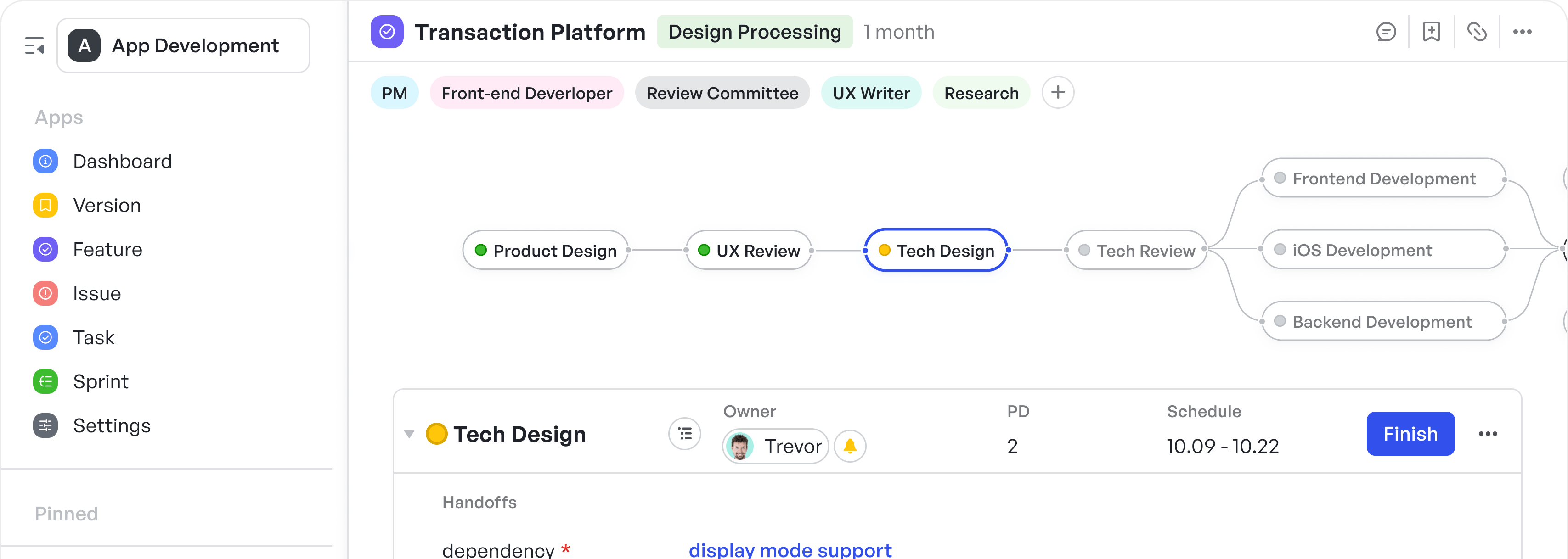If you're torn between Asana vs ClickUp, you're not alone. Both tools are incredibly popular, especially among remote teams and office workers. They each come with a solid set of features designed to streamline project management, so how do you choose?
On the one hand, you have Asana, an experienced player who often appears in discussions of the best project management software. On the other hand, there's ClickUp—a newer, more flexible platform that has been gaining serious traction.
The ClickUp vs Asana debate is a tough one, but that's where we come in. By the end of this comparison, you'll clearly understand which tool is best for your team. Our expert reviewers thoroughly examined both tools so you can make an informed decision.
ClickUp vs. Asana: At a Glance
If you're after traditional project management that’s easy to learn and has solid integration options, Asana is your best bet. It’s straightforward, so new users can quickly get the hang of it.
On the other hand, ClickUp is ideal if you need a highly customizable all-in-one workspace. It’s a good choice for teams that want advanced features without a hefty price tag.
Below is a comparison table for ClickUp vs. Asana:
Keep reading to learn more about our hands-on experiences with both platforms.
Feature Comparison
Let's know what ClickUp and Asana have in common (and where they differ!)—likely more than you’d expect. Here’s a closer look.
Forever-Free Plan
ClickUp and Asana are very different when it comes to their free and paid plans. Asana’s free plan offers unlimited projects, tasks, activity logs, assignees, due dates, and unlimited storage. However, file uploads are capped at 100MB. You also get access to core features like time tracking, list, board, and calendar views, along with most training resources and integrations.
ClickUp’s Free Forever plan includes a wide array of features, though some have limited usage. It provides multiple view options, integrations, collaboration and communication tools, time-tracking, sprints, and basic security measures. It also allows unlimited tasks, users, and custom views.
Automations
ClickUp offers generous automation options right from its free plan, while Asana requires a paid subscription to access automation features.
250px|700px|reset
加载中,请稍后
With ClickUp, getting started with automation is simple, even if you’re new to it. You can use ClickUp’s pre-made automation templates as a starting point, and once you’re comfortable, create your own custom automations tailored to your needs. You can automatically adjust assignees, priorities, or task statuses based on any custom logic you choose.
Both platforms include built-in automation tools, but Asana’s are only available on paid plans.
250px|700px|reset
加载中,请稍后
An example of Asana’s workflow creation
Asana's automation interface isn’t the most intuitive. While it offers a solid range of pre-made automations, accessing them can be a bit cumbersome (you’ll need to go through Customize > Rules > Add > Browse Library). Although there’s a learning curve, Asana’s automations are powerful once you get the hang of them, especially with its flowchart-style designer for creating workflows visually.
However, to fully customize automation workflows, you’ll need the Business plan, which can get pricey for larger teams.
250px|700px|reset
加载中,请稍后
ClickUp, on the other hand, lets you enjoy customizable automations on its free plan, with an allowance of 100 automations per month. If you need more, you can get 1,000 automations for only $5 per user monthly.
Customization
ClickUp offers a huge range of customization options, letting you build custom dashboards to track everything from tasks to timesheets to embedded content from around the web. Its structure includes multiple hierarchy levels, starting with Spaces for different teams or types of projects. Each Space is then broken down into lists, which can be grouped into separate Folders for even more organization.
If you're new to project management apps or prefer something simpler, ClickUp's features might feel complicated. The combination of Lists and Folders can seem redundant, especially when setting up a workspace for the first time. For example, deciding whether each client should have their own List within a Folder or if all client work should be grouped into one List can cause confusion. However, for larger teams that require complex data structures, these features offer clear value.
Plus, ClickUp recently launched ClickUp Brain, its built-in AI assistant that helps with writing and answers questions about your workspace’s content.
Asana also has a basic AI assistant that can summarize tasks and suggest subtasks, but ClickUp's version goes a step further.
Conversely, Asana provides basic customization options, including custom fields and workflows, to tailor the platform to your project needs. You can create reusable project templates, automate recurring tasks, and customize task forms to streamline processes.
For larger organizations, Asana's Enterprise plan offers advanced security features, compliance management, priority support, and enhanced integrations, making it a great fit for teams with more complex project requirements.
Pricing & Plans
As mentioned before, both ClickUp and Asana offer Free plans with a wide array of features. However, when it comes to paid plans, ClickUp’s most affordable plan, called Unlimited, is priced at $7 per user monthly if paid annually, or $10 if paid monthly. Asana’s lowest paid tier costs more at $10.99 per user monthly with an annual commitment, or $13.49 monthly.
250px|700px|reset
加载中,请稍后
ClickUp also offers a Business plan at $12 per user monthly with annual billing or $19 if paid monthly. Asana’s next tier, the Advanced plan, has a significant price jump to $24.99 per user monthly on an annual plan or $30.49 month-to-month.
250px|700px|reset
加载中,请稍后
For larger teams, ClickUp has a scalable Enterprise plan with custom pricing. Asana’s top tier is its customizable Enterprise plan as well. With ClickUp’s Business plan offering similar features to Asana’s Advanced plan, ClickUp generally provides more value.
Overall, Asana’s pricing is on the higher side, while ClickUp tends to be more affordable and offers more flexibility across its plans.
Customer Service & Support
ClickUp makes sure you’re covered with 24/7 live support, completely free of charge! Whether you’re a long-time user or just getting started, ClickUp’s team is always available to answer any question you might have. It all begins at the ClickUp Help Center, a go-to spot for any type of support you might need.
You can easily reach the Help Center from your Workspace, any ClickUp page, or your browser. From there, you can filter your search to get to answers even faster.
250px|700px|reset
加载中,请稍后
You can simply type your question into the search bar, connect directly with the Support Team via chat, or select from four primary resources:
- ClickUp API: Get instant access to in-depth documentation that helps you create custom integrations. ClickUp’s public API lets you enhance your experience with flexible integration options to fit your needs.
- ClickUp University: Whether you’re diving into a new feature or learning a specific use case, ClickUp University has you covered. It’s packed with curated courses that boost your skills and productivity right from your Workspace.
- Webinars: Ideal for teams exploring ClickUp for the first time, Webinars offer on-demand sessions that demonstrate the full potential of your Workspace. These free, visual sessions make learning interactive and accessible.
Asana, meanwhile, takes a minimalist approach to support. Its Asana Support page provides pre-set prompts based on common questions or issues. As you select prompts, you’re guided further to find the specific help you need. Asana offers other customer support options, but some require a paid plan and a bit more effort to locate.
Asana also provides 24/7 chat support from its Help Center and includes a detailed user guide to help you through onboarding. Additionally, Asana users have access to:
- Asana Academy: Training, webinars, and interactive courses to help you master the platform.
- Asana Forum: A lively discussion forum with experts and answers, although some areas are restricted to account holders.
- Instructor-led Training: Weekly live training sessions hosted by customer success representatives.
Who is Asana Best For?
Asana’s early success in the project management software space, combined with its user-friendly design, has made it a go-to tool for many teams. Its simple interface and real-time updates have made it a favorite for those seeking straightforward task management.
250px|700px|reset
加载中,请稍后
The platform’s collaboration features and integration options further add to its appeal, especially for small to medium-sized teams who need a reliable and easy-to-use solution. Asana’s familiarity factor ensures that teams can quickly adapt, making it easy to get started with minimal learning curve over time.
This simplicity makes Asana a great choice for teams that prioritize efficiency and straightforward project management. Marketing, design, and content teams, in particular, benefit from its clear organization and focus on collaboration. With its clean layout and accessible task-tracking tools, Asana excels in environments where project visibility and easy delegation matter most.
Asana’s simplicity extends to its usability. With clear navigation, intuitive labels, and a contrasting color palette, it’s easy to find your way around. In comparison, ClickUp can be a bit trickier, with some unclear labels like "LineUp" and "Trending," making it harder to locate specific features.
Asana’s side navigation menu is straightforward, featuring icons and labels for tasks, reports, and more. If you get lost, you can quickly return to the home screen, where you'll see your priorities, recent projects, and collaborators. The dashboard is customizable, allowing you to arrange widgets and set your own background.
250px|700px|reset
加载中,请稍后
Within a project, you’ll find an "Add task" button or simply click into any section to add tasks directly there.
250px|700px|reset
加载中,请稍后
From there, tasks can be easily dragged and dropped into the right section or order. You can also assign tasks, set due dates, and add subtasks with just a click.
In calendar view, color-coding tasks and events are simple to implement, making everything clearer and easier to manage.
250px|700px|reset
加载中,请稍后
Here’s a quick look at some of Asana’s best features:
- Create multiple workspaces for various projects and organizations
- Choose from several project views, including list, board, and calendar (Gantt charts are available for paid users)
- Use pre-built automation templates to streamline workflows
- Customize automation logic with Asana Rules
- Integrate with popular apps like Slack, Zoom, Microsoft 365, Google Drive, Dropbox, and Adobe Creative Cloud
- Track key project statuses easily
- Use Asana Goals to monitor company objectives (available in Business and Enterprise plans)
While Asana’s features aren’t novel or groundbreaking, that’s exactly the point—it does what you expect, making it a smooth and intuitive experience.
Who is ClickUp Best For?
ClickUp offers hundreds of advanced features that keep teams running smoothly. Instead of juggling multiple tools, teams can work efficiently in one centralized platform. Whether it's planning strategies, managing sprints, or tracking goals and progress, ClickUp covers all aspects of project management.
250px|700px|reset
加载中,请稍后
The platform's true strength lies in its flexibility. It can be fully customized to meet the needs of any team, whether they have complex workflows or unique preferences. This level of adaptability makes ClickUp an ideal solution for growing businesses in various industries. It’s perfect for tech-savvy groups and large teams with complex workflows. Unlike simpler tools, ClickUp adapts to detailed, layered structures with options for Spaces, Folders, and Lists.
One feature ClickUp excels at is the task tray in the top-right corner. It’s always accessible, no matter where you are in the app. From here, you can quickly create a new task, doc, or note, add a reminder, record a video clip, or check your calendar. Plus, you can sync your Google Calendar with ClickUp, so your upcoming events show up alongside your tasks.
Here’s an overview of ClickUp’s key features:
- Over 15 custom project views, including mind maps, Gantt charts, spreadsheets, and virtual whiteboards
- Pre-built and custom automation templates for streamlined workflows
- Automatic progress tracking with ClickUp Goals
- Built-in instant messaging for easy team communication
- Advanced dashboards with 50+ customizable card variations
- Ready-to-use customizable templates, including agile project management options
- In-app video recording for quick updates and collaboration
- Project hierarchy structure for better organization
- Built-in time tracking for monitoring productivity
- Integrates with over 1,000 tools, including Slack, Zoom, GitHub, Loom, Google Drive, Dropbox, HubSpot, Google Calendar, and Discord
With all these features, it's no wonder ClickUp has gained the trust of teams and businesses worldwide.
Alternatives to Asana and ClickUp
When it comes to project management software, Asana and ClickUp are often at the top of the list, each offering unique features and strengths.
However, if you're looking for something that brings the best of both worlds—simple yet powerful, lightweight yet feature-packed—then Meegle might just be the perfect fit.
With its clean interface and seamless integration of project and documentation management, Meegle is the top choice for teams who want to optimize their workflows without getting confused by unnecessary complexity.
How Meegle Fits In
Connecting a project management tool with other apps in your tech stack enhances productivity. Both Asana and ClickUp offer free plans with native integrations, making it easy to link up with other tools. Asana works with over 200 apps, while ClickUp integrates with an even more impressive 1,000+ apps.
However, if you're managing more complex, cross-functional projects, Meegle could be the better option. Its advanced task dependency visualization and unparalleled customization features make it ideal for handling intricate workflows and ensuring seamless project execution. These features work together to create a flexible, automated workflow.
Here’s a closer look at how Meegle helps streamline effective project planning and management through its powerful features:
Visualize every step with the workflow design
Asana and ClickUp focus on basic task automation, and Meegle takes workflow design to a more dynamic level. With node-driven workflows, you can break down projects into granular nodes and links that reflect the real complexity of your work.
250px|700px|reset
加载中,请稍后
Extract and visualize every step, from the beginning to the end
Unlike traditional workflows that merely automate repetitive tasks, Meegle iteratively refines workflows across multiple development cycles, fostering adaptability in dynamic environments. This ensures your team can remain agile and responsive to changes without disrupting the flow.
Meegle also allows you to visualize critical paths and dependencies clearly, making it easier to spot potential bottlenecks and prevent delays. The result? A more intuitive, detailed, and adaptable system that empowers your team to manage even the most complex projects with ease—something Asana and ClickUp struggle to match.
Meegle’s workflow design adapts to your needs, not vice versa.
Track relationships with task dependencies
While tools like Asana and ClickUp offer basic dependency tracking, Meegle takes it further with an advanced system for managing task relationships. It maps both upstream and downstream tasks, showing exactly how one task’s progress impacts others across the project.
Meegle provides clear, comprehensive visuals that let you see your entire project as an interconnected web. You can easily track how tasks relate to each other and where potential roadblocks might appear.
250px|700px|reset
加载中,请稍后
Set up workflows that move forward with clear directions
For example, in a software development project, front-end and back-end tasks need to align before testing can begin. Meegle’s visualizations ensure there’s no overlap or miscommunication, keeping the team on the same page about priorities and deadlines. Unlike competitors, Meegle ensures that task dependencies are always clear and aligned, preventing delays and confusion.
High level of customization
250px|700px|reset
加载中,请稍后
Customize workflows and create personalized task fields with Meegle's flexible options
Asana is a solid choice for simpler projects, offering easy-to-use templates that prioritize speed and simplicity. It works best when you need a quick, no-fuss solution. However, as projects grow in complexity and require more customization, Meegle is a better fit.
Meegle offers advanced customization that goes far beyond basic tools. It includes field types like text, roles, voting, and node synchronization, plus tailored automation rules to streamline business processes. With custom work items and fields, Meegle ensures your project management system aligns perfectly with your unique business needs.
Organize your projects the way you need with project hierarchy
Meegle’s Tree View takes project hierarchy to the next level with unmatched customization. Teams can build multi-level hierarchies that capture everything from broad goals to specific tasks.
250px|700px|reset
加载中,请稍后
Capture everything from long-term goals to small tasks, with a customized hierarchy
Whether you’re managing goals, epics, and features in software development or deliverables and tasks in marketing, Meegle allows you to tailor the structure to fit your needs. This flexibility ensures the tool adapts as your project becomes more complex, providing a bird’s-eye view of progress.
Meegle’s ability to seamlessly navigate between different levels of detail makes it easy for project managers to stay on top of everything. Unlike other tools that force rigid structures, Meegle lets you design the hierarchy that works best for your team.
Tailored customization, designed for your own needs
Meegle goes beyond one-size-fits-all templates with deep customization options that adapt to your team’s specific needs, including:
- Role-based pathways: Toggle roles on and off, add or remove nodes, and adjust workflows based on each team member’s role.
- Field customization: From text and numbers to unique data types like voting or synchronization fields, Meegle offers unmatched flexibility.
- Process tuning: Tailor your workflows with automation rules, notifications, and integrations, so the tool fits your needs, not the other way around.
250px|700px|reset
加载中,请稍后
Build products with a deep level of personalization
This level of personalization empowers your team to build systems that reflect your unique processes, goals, and challenges, ensuring efficiency and alignment across the board.
Stay ahead of problems with proactive issue management
Meegle’s proactive issue tracking keeps your projects on track by ensuring quick identification and resolution of issues before they disrupt progress. The platform allows teams to carry out tasks such as:
- Detailed logging: Teams can log all relevant information about issues, including type, priority, and related tasks. This granular approach makes it easier to understand the context of the problem, prioritize resolution efforts, and assign the right team members to address it. Detailed logging also serves as a valuable historical record, enabling teams to track recurring issues and learn from past challenges.
250px|700px|reset
加载中,请稍后
Quickly identify and resolve issues
- Workflow integration: Issues are seamlessly integrated into your existing workflows, meaning that each problem is automatically connected to the relevant stages of the project or development cycle. This tight integration allows for easier issue identification.
- Continuous visibility: Meegle ensures that critical bugs or risks are always visible. This prevents delays that could otherwise gether over time, particularly in agile environments where iterative progress depends on quick adaptation and timely decision-making.
By making issue management an ongoing process, Meegle helps maintain quality and prevents small problems from turning into major setbacks. This approach ensures your team can continue working smoothly, even when challenges arise.
Make your products agile-ready for continuous delivery
Agile teams benefit greatly from Meegle's thoughtfully structured tools, designed to support efficient collaboration and streamlined workflows. The platform offers list views with hierarchical relationships, allowing teams to clearly visualize and organize goals, epics, features, and issues.
This structure provides transparency at every level, ensuring that all team members are aligned on the scope, status, and timeline of each deliverable.
250px|700px|reset
加载中,请稍后
Stay aligned and efficient with agile project management
Meegle also simplifies the monitoring of release progress, giving project managers the insights they need to make informed decisions, track milestones, and delegate tasks effectively.
By adhering to core agile principles—transparency, adaptability, and inspection—Meegle helps teams consistently deliver customer value while staying focused and productive.
Asana vs ClickUp: Which is the Best Tool?
Asana and ClickUp each offer different needs and work styles, so choosing the “better” one depends on your team’s goals. If you need a feature-packed, customizable tool to handle complex workflows, ClickUp might suit you well. But if your team values simplicity and an intuitive interface, Asana could be the ideal choice.
If you're looking for a mix of both worlds—combining projects and documentation in one lightweight, efficient platform—Meegle is your go-to platform.
Ultimately, trying all three tools with your team can help you find the perfect fit.
FAQs
What is the difference between ClickUp and Asana?
ClickUp is highly customizable with a wide range of features, ideal for complex workflows. Asana offers a simpler, more intuitive interface, best for teams seeking ease of use.
Why is ClickUp better?
ClickUp stands out with its flexibility and all-in-one platform, supporting diverse team needs. It offers more advanced features for free, making it ideal for growing teams.
What makes Asana different?
Asana is known for its user-friendly interface and ease of use. It’s perfect for teams that prefer a simple, straightforward tool for task and project management.
What is Asana vs Jira?
Asana is a general project management tool for various teams, focusing on simplicity and collaboration. Jira is tailored for software development teams, offering robust features for agile project management.





